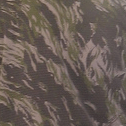Tigerstripe
| Tigerstripe | |
|---|---|
 Sample of a Lebanese-made tigerstripe fabric | |
| Type | Military camouflage pattern |
| Place of origin | Unknown |
| Service history | |
| Used by | See Users |
| Wars |
Vietnam War War in Afghanistan (2001–present) |
| Production history | |
| Designer | Numerous |
| Manufacturer | Numerous |
Tigerstripe is the name of a group of camouflage patterns developed for close-range use in dense jungle during jungle warfare by the South Vietnamese Armed Forces and adopted by US Special Forces during the Vietnam War. During and following the Vietnam war the pattern was adopted by several other Asian countries. It derives its name from its resemblance to a tiger's stripes and were simply called "tigers." It features narrow stripes that look like brush-strokes of green and brown, and broader brush-strokes of black printed over a lighter shade of olive or khaki. The brush-strokes interlock rather than overlap, as in French Lizard pattern (TAP47) from which it apparently derives.
There are many variations; R.D. Johnson counted at least 19 different versions in early drafts of Tiger Patterns, his definitive work on the subject, although it is unclear if these are all different print patterns, or if they include color variations of a few different print patterns.
History
_Nine_One_crouch_low_and_move_together_on_the_deck_aboard_the_amphibious_dock_landing_ship_USS_Fort_McHenry_(LSD_43).jpg)
It is unclear who developed the first tigerstripe pattern, consisting of sixty-four (64) stripes. The French used a similar pattern (Lizard) in their war in Vietnam.[1] After the French left Vietnam, the Republic of Vietnam Marine Corps continued using the pattern, a variant of which was later adopted by Vietnamese Rangers (Biệt Động Quân) and Special Forces (Lực Lượng Đặc Biệt). When the United States began sending advisors to South Vietnam, USMAAG advisors attached to the ARVN were authorized to wear their Vietnamese unit's combat uniform with US insignia. Soon, many American special operations forces in the Vietnamese theater of operations wore the pattern, despite not always being attached to ARVN units: it became the visible trademark of Green Berets, LRRPs, SEALs, and other elite forces.
Tigerstripe was never an official US-issue item. Personnel permitted to wear it at first had their camo fatigues custom-made by local tailors, ARVN uniforms being too small for most Americans; for this reason there were many variations of the basic tigerstripe pattern. From 1964 5th Special Forces Group contracted with Vietnamese and other Southeast Asian producers to make fatigues and other items such as boonie hats using tigerstripe fabric. Being manufactured by different producers, there were a wide variety of patterns and color shade variations. They were made in both Asian and US sizes. During the latter stages of the war, tigerstripe was gradually replaced in American reconnaissance units by the-then-new ERDL[2] pattern, a predecessor of the woodland BDU pattern. The Special Forces-advised Civilian Irregular Defense Group (CIDG) used tigerstripes from 1964 until disbanded in 1971. Special Forces personnel wore tigerstripes when conducting operations with the CIDG.
Besides American and ARVN forces, Australian and New Zealand military personnel used tigerstripe uniforms while on advisory duty with the ARVN units.[3] Personnel from the Special Air Services of Australia and New Zealand were the principal wearers of tigerstripe uniforms (and ERDL uniforms) in theater, while regular Australian and New Zealand troops wore the standard-issue olive drab green uniforms.
Outside of Vietnam, Thailand and Philippines have been the most prolific manufacturers of tiger stripe designs since the Vietnam War. The pattern became popular throughout the Middle East and South America as well.
Users
.jpg)
Current



















Former






See also
References
- ↑ http://www.kamouflage.net/camouflage/00104.php
- ↑ http://www.kamouflage.net/camouflage/00053.php
- ↑ McNab, Chris (2002). 20th Century Military Uniforms (2nd ed.). Kent, UK: Grange Books. ISBN 1-84013-476-3.
- ↑ http://camouniforms.net/index.php/oceania/australia/commercial-patterns/opfor-tigerstrip-commercial/1591-rothco-tigerstripe-jacket
- ↑ http://camouniforms.net/index.php/oceania/australia/commercial-patterns/opfor-tigerstrip-commercial/1592-2018-03-02-08-17-17
- ↑ https://www.middleeastmilitaria.com/iraqitigerstripecamo.html
- ↑ http://www.camouniforms.net/index.php/eastern-europe/russia/tiger-kamysh-patterns/green-kamysh/787-green-kamysh-jacket
- ↑ http://www.camouniforms.net/index.php/eastern-europe/russia/tiger-kamysh-patterns/green-kamysh/788-2014-03-10-14-05-59
- ↑ http://militaryland.net/ukraine/special-police-forces/bohdan-company/
- 1 2 https://www.iwm.org.uk/collections/item/object/30097665
- ↑ http://www.camouniforms.net/index.php/south-america/ecuador/345-red-tiger-stripe
- 1 2 https://www.complex.com/style/2013/08/guide-to-camouflage/1969-dpm-uk
- ↑ http://www.camouniforms.net/index.php/asia/taiwan/roc-marine-corps-tiger-stripe/551-roc-marine-corps-tiger-stripe-shirt
- ↑ https://epochs.co/features/epochs-field-guide-to-camouflage
Further reading
- Johnson, Richard Denis (1999). Tiger Patterns: A Guide to the Vietnam War's Tigerstripe Combat Fatigue Patterns and Uniforms. Schiffer Pub Ltd. ISBN 978-0-7643-0756-0.
External links
| Wikimedia Commons has media related to Tigerstripe. |
- Tiger Stripe Boonie Article RallyPointMiliaria.com 2009
- Influence of tigerstripe on U.S. Marines MARPAT uniform
- Airman Battle Uniform based on tigerstripe
- Development of modern tigerstripe by U.S. Air Force
- The short film STAFF FILM REPORT 66-21A (1966) is available for free download at the Internet Archive
- The short film STAFF FILM REPORT 66-25A (1966) is available for free download at the Internet Archive
.jpg)